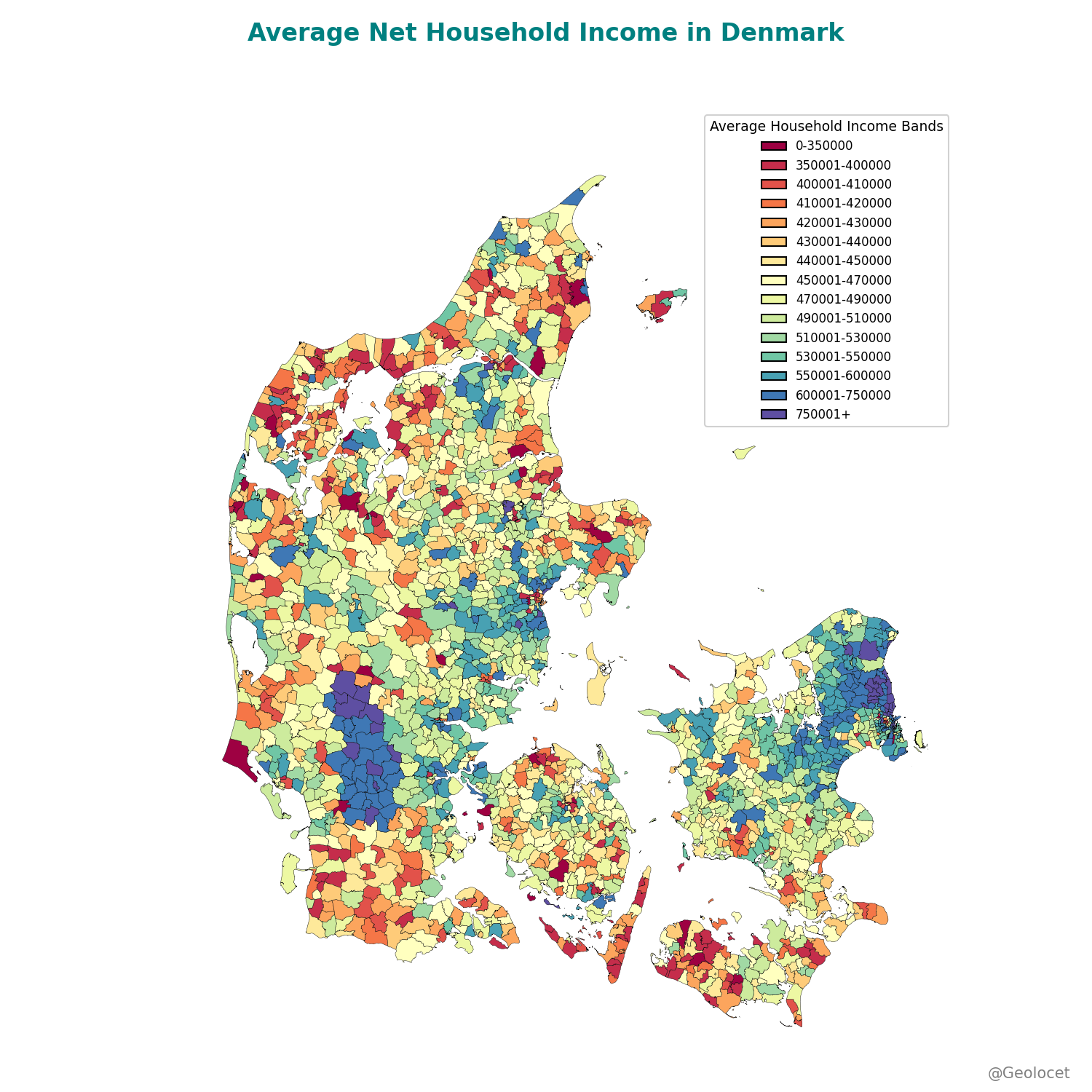Introduction
Denmark is often cited as a highly equal country, but parish-level analysis reveals notable local differences. Using Geolocet’s dataset — including average household disposable income by parish (sogn) — this article highlights spatial patterns of prosperity and deprivation and their implications for business, planning and research.

Income distribution in Copenhagen’s parishes
Copenhagen displays wide variation within short distances. The central and northern parishes record the highest income levels, while western and southern parishes tend to show lower averages. Examples of high-income parishes include Garnisons, Østervold, Kastels, Rosenvænget, Holmens and Sankt Pauls, all falling into income bands of 600,000–750,000 DKK or higher. In contrast, parishes such as Tingbjerg and Solvang fall into the lowest income band (below 350,000 DKK).
Highest income parishes in Denmark
The wealthiest parishes in Denmark are largely concentrated in the northern suburbs of Copenhagen, extending into areas known for high property values, proximity to green spaces, and professional employment bases. Outside the capital region, select parishes in Aarhus, Aalborg, and Billund also feature prominently among the top income bands.
- Gentofte Municipality — One of Denmark’s most affluent municipalities, characterised by leafy residential neighbourhoods, proximity to Copenhagen, and high educational attainment. Wealth is concentrated in parishes such as Helleruplund, Gentofte, Jægersborg, Ordrup, Maglegårds, and Hellerup.
- Rudersdal Municipality — Stretching north of Copenhagen around lakes and forests, Rudersdal combines scenic settings with high-income households, many commuting to the capital. Parishes such as Søllerød, Vedbæk, Ny Holte, and Birkerød show some of the highest incomes nationwide.

- Lyngby-Taarbæk Municipality — Known for its university campus and strong business presence, Lyngby-Taarbæk hosts prosperous residential areas like Virum, Sorgenfri, and Taarbæk. High educational levels and executive employment patterns contribute to disposable incomes exceeding 750,000 DKK on average.
- Hørsholm and Fredensborg Municipalities — These neighbouring municipalities are part of the “Whisky Belt,” featuring coastal villas and forest surroundings. Parishes such as Rungsted, Hørsholm, and Asminderød-Grønholt maintain consistently high household incomes and property values.
- Aarhus Municipality (Jutland) — Within Denmark’s second-largest city, affluent suburban parishes like Skåde and Risskov stand out with household disposable income levels comparable to those in northern Zealand. These areas attract professionals and families drawn by coastal locations and quality housing.
- Aalborg Municipality (Northern Jutland) — The Hasseris parish, west of central Aalborg, remains one of the wealthiest outside the Copenhagen region, reflecting a concentration of high-income households and established residential neighbourhoods.
- Billund Municipality (Southern Jutland) — Though smaller in population, Billund shows remarkably high income levels driven by its industrial and corporate base. The town of Billund Parish hosts the headquarters of LEGO and Billund Airport, both major employers supporting high local disposable incomes and a strong economy relative to its size.
Parishes with the lowest household disposable income
Parishes in the lowest income band (below 350,000 DKK) are mainly found in rural municipalities such as Lolland, Guldborgsund, and parts of Funen and western Jutland. These areas often experience smaller local economies and limited access to high-paying employment opportunities. Urban examples include Vollsmose (Odense) and Gellerup (Aarhus), both known for social housing concentrations and diverse demographic profiles.
Key insights
- Regional divide: Northern Zealand concentrates the highest household incomes, while rural municipalities and specific urban districts exhibit much lower levels.
- Urban inequality: Within major cities such as Copenhagen and Aarhus, parishes can differ by more than 400,000 DKK in average disposable income.
- Strategic value: Parish-level data enables nuanced understanding of local purchasing power, supporting targeted retail site selection, infrastructure planning, and socio-economic research.
About the data
The dataset used in this analysis is derived from official statistics published by Statistics Denmark (Danmarks Statistik). The original data provide household disposable income and related socioeconomic indicators at the municipality level.
To enable detailed spatial analysis, the Geolocet data science team modelled these values further down to the parish (sogn) level using robust statistical methods. This process integrates multiple relevant variables available at parish level, including population counts, age structure, employment ratios, and housing characteristics. The resulting dataset offers a consistent and reliable view of income distribution across Denmark’s 2,000+ parishes.
The Denmark Parish Income Indicators dataset is available through Geolocet’s data platform. It includes parish-level figures for average household disposable income, income band classification, and associated demographic variables, making it suitable for retail site assessment, regional planning, and socioeconomic research.
Conclusion
While Denmark remains one of Europe’s most equal societies, parish-level data demonstrate persistent spatial income patterns. The concentration of wealth north of Copenhagen, alongside notable high-income clusters in Aarhus, Aalborg, and Billund, underscores the value of fine-grained geographic data for planning, investment, and research.
Similar Products
If you're interested in datasets like this one, here are other income indicator products you may want to explore:
- Belgium: Download Income Indicators at statistical sector Level
- Bulgaria: Download Income Indicators at Municipality Level
- Germany: Download Income Indicators at Small Area Level
- Greece: Download Income Indicators at Municipality Level
- Italy: Download Income Indicators at Municipality Level
- Ireland: Download Income Indicators at Small Area Level
- Finland: Download Income Indicators at Post Code Level
- France: Download Income Indicators at IRIS Level
- Portugal: Download income Indicators at Freguesia level
- Spain: Download Income Indicators at Statistical Sector Level
- Sweden: Download Income Indicators at Statistical Sector Level
- United Kingdom: Download Income Indicators at Small Area Level

